You are reading the older HTML site
Positive Feedback ISSUE
4"I Don�t Drive Stock!" Chapters 5 and 6: In Which Yon Editor Has
His Op-amps and Regulators Done - Then Discovers that Audiocom’s Superclock
II is Exceptional!
by David Robinson
The Upgrades Continue
Yep, it's about that time again! Another report from River City on the possibilities of SACD mods, that fine process of taking what's good and working hard to turn it into something great. It can be done, and it does make a very real difference. I've been doing the mods in a series of discrete stages, so that I can give you some idea of my impression of the incremental changes that each modification offers. Our hope is that this will give you some idea of what might be best for your SACD player, given your preferences and budget.
Those of you who have been following my fearless adventures know that Richard Kern of Audiomod (www.audiomod.com) has been modding my reference Sony SCD-1 SACD player. (If you're new to the series, I recommend that you catch up on the three prior modification articles in Positive Feedback Online Issues 1, 2 and 3; for browsing convenience, you'll find them at www.positive-feedback.com/Issue1/issuetoc.htm, www.positive-feedback.com/Issue2/drmods.htm, and www.positive-feedback.com/Issue3/drmods.htm. This will give you a sense of what earlier mods did to the sound of the SCD-1.) This time around, we were going to do upgrades to the op-amps and regulators on the power supply board, and leave it at that for this issue…but then along came the new Audiocom Superclock II.
About that critter, more in a bit...
Doing the Op-amps and Regulators

Audiocom Op-amp
Having previously done the original Superclock, the Superclock Power Supply (both of these using the silver hookup wire, by the way), the Black Gate caps, and the Vishay resistors, Richard reckoned that the next modification ought to be the replacement of the stock op-amps (for the record, on the Sony SCD-1 these are marked "BB OPA2604AP 9929 4818" x 2) and power regulators (these look to be Mitsubishi 7800 series and 7900 series x 5). The stock regulators were to be replaced with the Audiocom Super Regulators; the standard op-amps with the appropriate Audiocom op-amps (these are labeled OPA627).
Op-amps have a bad reputation in the fine audio biz, and deservedly so. Some of the truly horrid stuff done in the past couple of decades deserves to be turned into tie tacks, Lego parts, or used as pavement filler by asphalt companies. On the other hand, I had an interesting conversation with John Ulrick of Spectron a few years ago on the subject of op-amps. It was his opinion that the best of the current generation of op-amps were truly good devices, quite capable of superior performance in modern fine audio applications. (I haven't talked to him recently, but assume that it's unlikely he's changed his mind on the subject.) He thought that audiophiles shouldn't assume that opamps were necessarily bad, or that they should never be used in audio; these were stereotypes that were no longer true in every case.
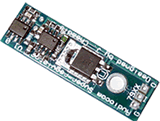
Audiocom Super Regulator
Power regulators perform the essential function in audio devices (and computers too, for that matter) of taking an incoming voltage, and assuring proper output voltage. Indifferent power regulation can degrade the sound of a component; bad regulators can actually imperil downstream ICs. (Just ask the fellow who has this happen with a computer motherboard!) The idea is to put high quality, high bandwidth, and low noise regulators into place to assure premium downstream performance on the SCD-1 power board.
The folks at Audiocom believe that they've come up with a superior design for both audio op-amps and regulators. Knowing that they could make difference, I was willing to give it a shot, especially since Richard Kern had listened to them and liked the improvements that he heard.
Richard was able to get the op-amp/regulators done in an afternoon, and ran the modified player in overnight. As usual, Richard displayed the sort of meticulous craftsmanship that I've come to appreciate in his work. At each step along the way, he explained what he was doing; I was able to make a number of photographs to illustrate the process (see below).
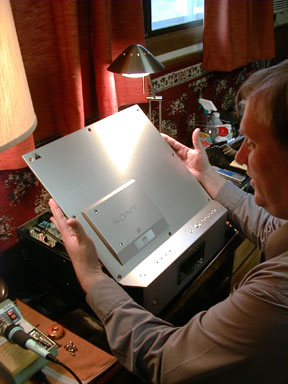
Looks familiar! Richard Kern opening PFO’s SCD-1 one more time!
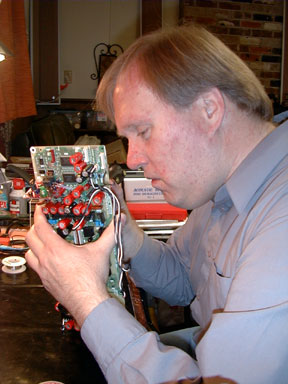
Kern closing in on yet another mod
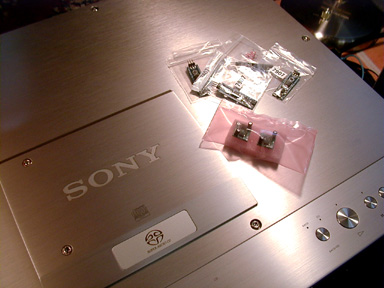
The two Audiocom op-amps (the2 units in the pink
bag) and the Audiocom
Super Regulators (the clear bags with 5 units) ready for installation on top of the
SCD-1…
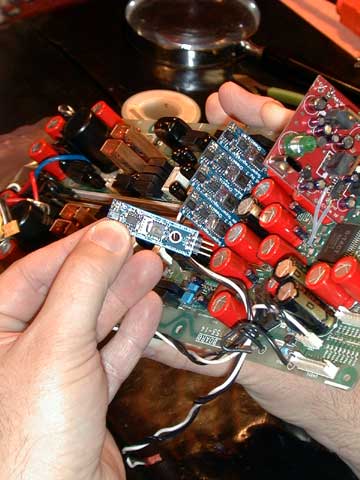
Kern places a Super Regulator on the SCD-1 power
board
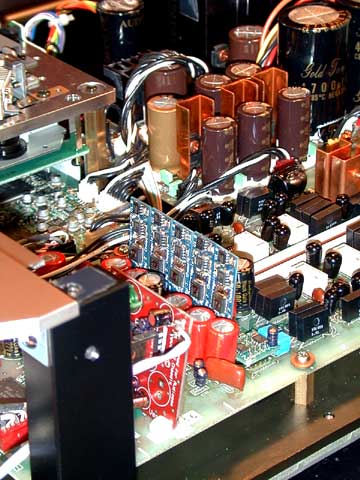
The Super Regulators in place (five modules just
behind the red caps;
just to the right of the regulators and just behind the caps is an Audiocom
op-amp; in front of the caps is the Superclock I.
I was looking forward to hearing what differences the new Audiocom parts would bring, and picked up the SCD-1 immediately after it was ready to go.
The Sound
One encouraging thing about doing these particular upgrades is that it didn’t take long for them to break-in. (Breaking in a Superclock, on the other hand, can take quite a while!) Within just a few hours of playing time, the SCD-1 seemed to hit an optimum point with little apparent further improvement.
I would characterize the changes that the op-amp/regulator upgrades brought to the SCD-1 in my listening room as imparting a definite quickness to the performance of the player. By this, I mean that the reproduction of SACDs seemed to be a shade more responsive to dynamic changes in the music, especially in more subtle passages. (Some audio lexicons would speak of an "improved microdynamics, I would guess.) Without changing its soundstaging or imaging, without shifting the marvelous sense of tonal neutrality that the earlier mods had given, it was as if the slew rate had improved. This may be the sort of thing that Art Dudley and the folks at the now-departed-and-lamented Listener were referring to when they spoke of "PRAT": Pace, Rhythm And Timing.
Better PRAT… no PRATfall!
Let me be sure that you don’t misunderstand me here. This "quickness" is not leanness in the sense that some audiophiles use the term. The music didn't lose warmth or surrender the natural bloom that fine SACDs can show so well; instead, it is as if there's a greater agility to the sound, a lilt... as if the SCD-1 was now "lighter on its feet."
However you would express this, quicker is what I would say…can't think of a better word. More responsive, faster on the draw in dynamic response... and all without hellaciously long break-in!
Otherwise, I heard no substantial changes to the sound, or losses to other qualities contributed by the other mods I've documented… and I've been listening to the results for a number of weeks now. This is a good thing; sometimes gains in one audio area can lead to losses in others. This upgrade was nicely additive.
"So... do I want to do this one or not?!"
Good question!
How do the cost-benefits stack up? Well, Audiomod lists the cost of the op-amp pair at $201; the Audiocom Super Regulators are $330 for the set of five; installation for the op-amps and regulators is $175. Thus, the grand total is $706 installed, not including shipping, handling and insurance both ways, which the customer pays. This sum buys results that are definite, but may be farther down on the list of "what's important" for some 'philes.
Let's put it this way—think about the Audiocom op-amp/regulator upgrades:
If you’re interested in this idea of "quickness" and improved PRAT with your SACDs, or
If you have a system that may be sounding a bit on the dark or heavy side, or
If you have a hefty budget, and are willing to spend whatever it takes to get the very best out of your SCD-1, SCD-777ES, or other moddable SACD player.
You'll have to make the choice, based on your finances, preferences and priorities. I'm glad that I did this, but I'm also pretty far down the road on modifying the SCD-1, too. Your mileage may vary.
STOP THE PRESSES! Audiocom’s Superclock II is a Winner!
Shortly after the op-amp/regulator upgrade was done on my SCD-1, Richard Kern contacted me to see if I would be interested in replacing my original Superclock with Audiocom's new Superclock II. This is a radical redesign of the whole Superclock system: a new PCB design, better oscillator, claimed better jitter rate (though no specifications were given on that one), shorter signal path, Black Gate caps. (For details, see www.audiocominternational.com/shop/superclock2.asp.) Richard told me that he had listened to one, as was very impressed with the improvements over the original Superclock.
Was I willing to pull my original Superclock and give the new one a try?
Absolutely!
Once More I Found Myself...
Sitting in Richard’s workshop, watching him pull the old Superclock from my SCD-1 and replacing it with the new model. When he showed me the Superclock II, I could definitely see that it was a major revision of the design.
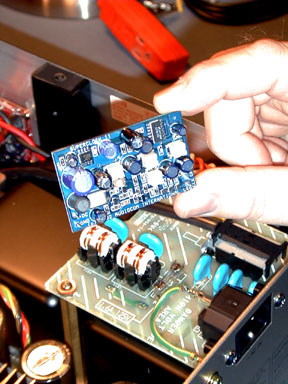
The new Audiocom Superclock II
The installation took about two hours, start to finish. The old unit was removed; the silver hookup wire was cleaned and readied for the new connections; then the new Superclock was dropped into place. Richard was clearly well practiced in doing this sort of thing. As always, I enjoyed watching an audio artisan do his work.
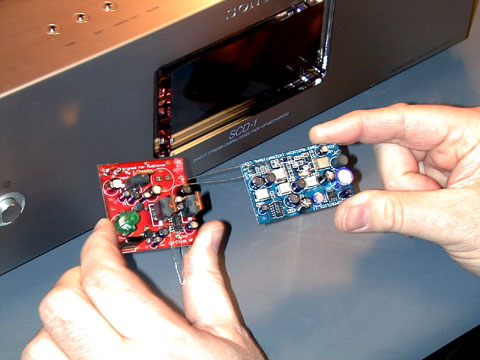
The old Superclock I (left) vs. the new Superclock
II (right)—very different indeed!
One question that I had, with visions of yet another 400 break-in cycle dancing in my head: How long will the break-in take?" Richard's answer was reassuring, if general (he was still new to the Superclock II himself): Not as long as the Superclock I. It seems to break-in more quickly."
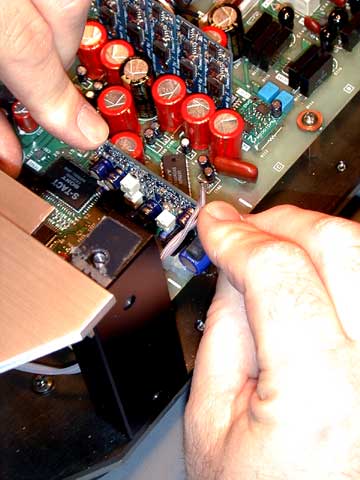
The new Superclock II going into place. Behind the
red Black Gate
caps are the bluish Super Regulators; the small greenish board to
the right of these and just behind the caps is one of the Audiocom op-amps.
I took the modded SCD-1 home to see for myself.
The Sound
At first... and as usual... the SCD-1 sounded a bit congested, and a bit rolled-off. I've been here before with SACD players and mods, though—not to worry! Just keep the SACDs rolling. I spent several days pumping music through it; after the first couple of days, the sound began to open up. My experience was that the Superclock II is pretty much there by somewhere in the 100-125 hour range. And this was not 100-125 hours of playing time; this was more like "just leave it on, and play music as you can during half of that time." Definitely a faster break-in!
The Superclock II showed real improvements over the original Superclock. I was struck by the following with every SACD that I tried in the newly modified player:
A definite further increase in transparency and clarity of musical presentation (and this was with the above op-amp/regulator upgrade already in place)
Better imaging... which was hard to imagine, since the original Superclock was such an improvement over Sony's stock clock
Slightly deeper soundstaging
Deeper, tighter bass reproduction
More "shimmer" on percussives, especially cymbals in drum kits
Further gains in dynamic/transient response
A noticeable improvement in the integration of all frequency ranges, immediately apparent on the exceptional Kharma Grande Ceramiques currently under review
For those who might ask, yes, you'll also see significant improvements on the CD side of things. I think that some would say that they're more amazed at the improvements on this side of the ledger, but not me: standard CDs have so far to go from where they are, that the improvements wrought by the Superclock II will be starkly evident.
What’s more, in my experience the Superclock II outperforms the old Superclock AND Superclock Power Supply upgrades put together! I am quite sure of this impression, having spent months evaluating those two upgrades in sequence.
This is truly amazing stuff. The Superclock II is simply better in every way than its predecessor.
There’s no reason to ramble on and on about this; it’s a waste of time. This is a slam-dunk no-brainer, amigos. If you're thinking about modifying your SACD player... if you do only ONE modification... then the Superclock II is it.
The good news is that the Superclock II is priced at a very reasonable $267; Audiomod charges $100 for the installation and testing. So, for $367 plus shipping and insurance both ways, you can easily take your SACD player to a much higher level. Frankly, I don't know any other investment that you could make in your SACD player at anything like this price that would give you nearly the return on your investment that the Superclock II will.
Consider this to be a "Ye Olde Editor's ‘Highest Recommendation.’" Enthusiastically!
For More Information
Richard Kern
Audiomod
4390 S.E. Mark Kelly Court
Oak Grove, OR 97267
web address: www.audiomod.com
email address: [email protected]
TEL: 503. 659. 6599
There are other modifiers who can install Audiocom parts:
Dan Wright
ModWright
1935 N.E. Cramer St.
Portland, OR 97211
TEL: 503. 351. 9743
web address: www.modwright.com
email address: [email protected]
TEL: 503. 287. 9083
Ric Schulz
Electronic Visionary Systems (EVS)
1112 Pilger Road
Boulder Creek, CA 95006
TEL: 408. 399. 9708 phone
email address: [email protected]
web address: www.tweakaudio.com (general)
web address: www.tweakaudio.com/EVS%20modified%20SACD%20players.html
(SACD specific)
As we become aware of other modifiers doing this work, we'll let you know.
For those in the USA who are interested in sourcing Audiocom (and other) parts and going the DIY route, contact:
Kyle Takenaga
Reference Audio Mods
16230 Stone Hill Court
Riverside, CA 92503
TEL: 909. 776. 0841 (Kyle Takenaga)
email address: [email protected]
web address: www.referenceaudiomods.com
For general information about Audiocom products:
Audiocom UK
web address: www.audiocominternational.com
